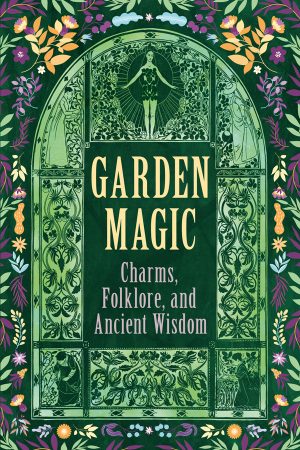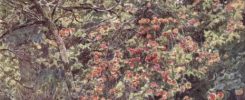Learn how to make your green space a sanctuary where all spirits of the garden can thrive.
Our gardens are a safe space for butterflies, birds, and other whimsical visitors. As you nurture your plants, flowers, herbs, and hedge, you should also honour and embrace all spirits of the garden, from the bees who pollinate your flowers to the spiders who spin protective webs, and even unseen beings, like fairies and nature spirits.
Discover the enchanting history of the world’s most magical plants to nurture your own garden with this spellbinding gardening companion.
Spirits of the Garden
What are spirits of the garden? How do magical nature spirits appear in our green spaces?
Witches were said to keep spirits in the likeness of toads and cats, as their ‘familiars’. (Lewis, 1918)
Never drive a robin away, for they eat woodlice, grubs, and worms, but do no harm to plants. A nice big toad—not a frog, but a rough, grey toad—is a most desirable friend, too, as he will eat ants, woodlice, and flies. Ants are sometimes most mischievous in a garden. They do not eat plants, but they eat certain aphides they find on the roots. Anyhow, they will kill your pet plant if they are so inclined. Lady-birds, as well as birds and toads, are friends in your garden, as they eat aphides. (Sidgwick and Paynter, 1909)
The children of Witches are elfish creatures, sometimes butterflies, sometimes bumble bees, sometimes caterpillars or worms. They are called good or bad things—Holds or Holdikens. (Folkard, 1884)
Fairies of the Herb Garden
Why are fairies so closely linked to our herb gardens, and how are witches and spirits of the garden connected in our folkloric history?
The herb garden was always the special domain of the housewife, and one likes to think of the many generations of fair women who made these gardens their own, tending them with their own hands, rejoicing in their beauty and peace and interpreting in humble, human fashion something of the wonder and mystery of Nature in the loveliness of a garden enclosed. For surely this was the charm of these silent secluded places, so far removed from turmoil that from them it was possible to look at the world with clear eyes and a mind undisturbed by clamour. And what of the fairies in those gardens? We live in such a hurrying, material age that even in our gardens we seem to have forgotten the fairies, who surely have the first claim on them. Does not every child know that fairies love thyme and foxgloves and the lavish warm scent of the old cabbage rose? Surely the fairies thronged to those old herb-gardens as to a familiar haunt. Can you not see them dancing in the twilight?
The dark elves of Saxon days have well-nigh vanished with the bogs and marshes and the death-like vapours which gave them birth. With the passing of centuries the lesser elves have become tiny of stature and friendly to man, warming themselves by our firesides and disporting themselves in our gardens. Perhaps now they even look to us for protection, lest in this age of materialism they be driven altogether from the face of the Earth. (Sinclair Rohde, 1922)
Garden Chowdi and Demons
Are all spirits of the garden kind-hearted and well-intentioned? Can we control or tame the beings that visit us in these spaces?
Some use mantras, or spells, by which they control the demons. (The word mantra may mean a hymn, a prayer or an invocation.) They demand, or compel them, at times, to guard their property. If a thief lay his hand upon any article in the house, or any fruit in the garden of a man so protected, he is unable to stir from the spot or withdraw his hand until the owner returns, and not even then until the spirit is ordered to set him free.
It is a common thing for the purchaser of a garden to take from the seller the mantram by which the garden chowdi (demon) is controlled; otherwise, he would not be able to enjoy the fruits of the field or orchard. Pisachas sometimes take possession of a house, a well or a tree. They are driven away by a mantriki (one possessing knowledge of mantras), by reciting charms, suspending jantras (cabalistic signs inscribed upon sheet-copper plaques) on the walls, sides or branches, as the case may be, and other devices. Sometimes when the Pisacha (spirit-control) is expelled from a medium he is obsessing, the mantriki will cut a lock of her hair, wrap it about an iron nail and drive the nail into a tree; the Pisacha is then bound to the tree until the nail rusts away. (Peebles, 1904)
Flower Faires and Fae
Why are fairies and other spirits of the garden so closely associated with flowers?
It was always a well-known fact that the fairies were passionately fond of most flowers; it is a part of their mission to give to each maturing blossom its proper hue, to guide creepers and climbing plants, and to teach young plants to move with befitting grace. (Kennedy-Bell, 1923)
Flowers were as naturally associated with fairies as with Sunshine, Moonbeams, and other bright, beautiful, or tricksy things. The ‘little people’ hid in flowers, made their cloaks of petals, their crowns of stamens, their darts of thorns, their cradles of lilies, their seats of fungi. As the burly gods of the Norsemen and the majestic deities of Greece represented nature as force, so the fairies personated nature’s gentler, daintier attributes. They were the souls of the flowers, flowers were wholesome.
The mottlings of the cowslip and the foxglove, like the spots on butterfly wings and on the tails of pheasants and peacocks, mark where elves have placed their fingers. On the foxglove these marks are dull and threatening, denotive of the baneful juices that the plant secretes, and which as digitalis (digitus: a finger) we turn to account in our pharmacopoeia. This evil quality gives to it the name of dead-man’s-thimbles in Ireland, and its patches are held to resemble those on the skins of venomed snakes. In Wales, the plant is known as the fairy glove, but it is Virgin’s glove or ‘gloves of our Lady’ in France, while in old English herbals it is witch’s glove, fairy thimble, fairy’s cap, folk’s glove; yet in Norway Reynard claims it again, for there it is fox bell. A legend of the North is that bad fairies gave these blossoms to the fox, that he might put them on his toes to soften his tread when he prowled among the roosts.
The anemone is a fairy shelter, curling up as night or storm approaches, and thus protecting its occupant, but the wee creatures sit oftener in the cowslip cups, and those human and undoubting souls that can listen at such a time with the ear of childhood hear a fine, high music, like a harmonised hum of bees. This oftenest comes from the flowers when the Sun is shining on them. In England the cowslip used to be the key flower, or key wort, or St. Peter’s wort, because the umbel is supposed to resemble the bunch of keys carried by St. Peter; indeed, the Germans still call it the key of heaven.
Fairies protect the stitchwort, and it must not be gathered, or the offender will be ‘fairy led’ into swamps and thickets at night. One of the oddest of beliefs is that St. Johnswort and ragwort are a day disguise of fairy horses. If you tread them down after Sunset a horse will arise from the root of each injured plant and that night will gallop about with you, leaving you at dawn either at home or far abroad, as it may happen. They have a kinder plant in China, although it bears the name of sin; for, being eaten, it changes a man to a fairy and gives him a long lease of youth.
England has a fungus known as fairy butter, and our country has fairy rings of toadstools and coarse grass that spring in the footsteps of the sprites as they dance. The fruit of the mallow is fairy cheese, toadstools are fairy tables, and the tiny cup fungi, like nests with eggs, are fairy purses. Our elm is elven, or elf tree, and fayberry is a name still extant for gooseberry. In Denmark a fairy is an elle, and elle-campane and elle-tree, or alder, are favourites with the ‘little people’. Should you stand beneath an alder at midnight on Midsummer Eve, you may see the king of the elles, or elves, go by with all his court (Skinner, 1911)
Learn more about the many magical spirits of the garden in our beautiful grimoire Garden Magic.



